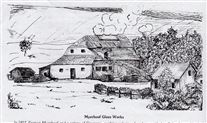2001.000.005.jpg
2001.000.005.jpg
Myerhoof Glass-works
In 1812, Francis Myerhoof, with a colony of Germans, located at this place, and engaged in the manufacture of glass-ware, building a manufactory for that purpose; also built several residences. Myerhoof is spoken of as a gentleman of education and refinement, and naturally appeared to some as rather aristocratic. After an outlay of many thousands of dollars, the glass-works were finally put in operation, the sand having to be hauled from Sand Pond, in the extreme north end of Hardwick township, a distance of twelve miles. The flint and wood used in the manufacture of the glass were products of Knowlton township. The factory gave steady employment to over thirty persons, and was in its way a great curiosity, people coming long distances to witness the operation of “glass blowing,” and to this day there are in the houses in this vicinity not a few mementoes of the skill of those old Germans, in the form of canes, mugs, etc.
In 1825, through various causes, the glass-works suspended operations, and Myerhoof was sold out by the sheriff, and the result was the transfer to other hands of nearly all the property at Columbia. The only German that settled here during the operation of the glass-works, and whose descendants still remain, was a Mr. Geiss, who came from Philadelphia about 1815, and purchased a tract of land, a part of which is now in possession of his descendants. After the failure of Myerlioff, Abram Pish became manager of the glass-works, who also was obliged to suspend business. He was succeeded by Liliendohals, who met with no better success than his predecessors, and gave up the business, when he was followed by a Mr. Smouth, who tried his hand at glass-blowing with ill success. The old saw-mill at the mouth of Paulinskill belonged to the glass-works, and was used iis a stamping-mill to pulverize the clay used in making glass.
